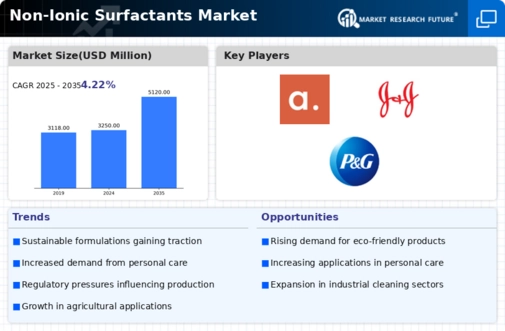Growth in Household Cleaning Products
The non ionic-surfactants market is significantly influenced by the expanding household cleaning products sector. With a growing emphasis on hygiene and cleanliness, particularly in urban areas, the demand for effective cleaning agents is on the rise. Non ionic surfactants are favored for their ability to dissolve oils and dirt without causing irritation, making them ideal for various cleaning applications. The household cleaning market in the US is expected to exceed $20 billion by 2025, with non ionic surfactants contributing to this growth. As consumers seek products that are both effective and safe for their families, the preference for non ionic surfactants is likely to strengthen, thereby enhancing their market presence. This trend underscores the importance of non ionic surfactants in meeting consumer expectations for performance and safety in cleaning products.
Rising Demand in Personal Care Products
The non ionic-surfactants market experiences a notable surge in demand driven by the personal care sector. Consumers increasingly favor products that are gentle on the skin and environmentally friendly. Non ionic surfactants, known for their mildness and effectiveness, are widely utilized in shampoos, lotions, and cleansers. The personal care industry in the US is projected to reach approximately $100 billion by 2025, with non ionic surfactants playing a crucial role in this growth. As consumers become more conscious of ingredient transparency and sustainability, the preference for non ionic surfactants is likely to increase, thereby propelling the market forward. This trend indicates a shift towards formulations that prioritize both efficacy and safety, positioning non ionic surfactants as essential components in personal care formulations.
Shift Towards Eco-Friendly Formulations
The non ionic-surfactants market is increasingly shaped by a shift towards eco-friendly formulations across various sectors. As environmental concerns gain prominence, manufacturers are compelled to develop products that align with sustainability goals. Non ionic surfactants, often derived from renewable resources, are perceived as more environmentally benign compared to their ionic counterparts. This trend is particularly evident in the cleaning and personal care industries, where consumers are actively seeking products that minimize environmental impact. The market for eco-friendly cleaning products is anticipated to grow at a CAGR of 7% through 2025, with non ionic surfactants playing a pivotal role in this transformation. This shift not only reflects changing consumer preferences but also indicates a broader industry movement towards sustainable practices, positioning non ionic surfactants as key players in the development of greener formulations.
Technological Innovations in Formulation
The non ionic-surfactants market is benefiting from ongoing technological innovations in formulation techniques. Advances in surfactant chemistry and formulation technology enable manufacturers to create more effective and efficient products. Innovations such as microemulsions and nanotechnology are enhancing the performance of non ionic surfactants in various applications, including personal care and industrial cleaning. These technological advancements are likely to drive market growth, as they allow for the development of products that meet evolving consumer demands for performance and safety. The market for advanced surfactant formulations is projected to grow significantly, with non ionic surfactants at the forefront of this evolution. This trend suggests that the non ionic-surfactants market will continue to evolve, driven by the need for innovative solutions that address both consumer needs and environmental considerations.
Increased Adoption in Industrial Applications
The non ionic-surfactants market is witnessing increased adoption in various industrial applications, including textiles, agriculture, and food processing. These surfactants are valued for their versatility and effectiveness in enhancing product performance. In the textile industry, non ionic surfactants are utilized for wetting, emulsifying, and dispersing agents, which are essential for achieving high-quality finishes. The agricultural sector also benefits from non ionic surfactants, as they improve the efficacy of pesticides and herbicides. The industrial applications segment is projected to grow at a CAGR of around 5% through 2025, indicating a robust demand for non ionic surfactants. This growth reflects the ongoing need for efficient and effective solutions across various industries, further solidifying the role of non ionic surfactants in enhancing operational efficiencies.

















Leave a Comment